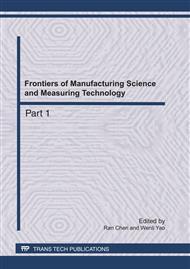[1]
Qunji Xue, Weimin Liu, Zhang Zhijun, Friction and wear properties of a surface-modified TiO2 nanoparticle as an additive in liquid paraffin, Wear 213(1997)29-32.
DOI: 10.1016/s0043-1648(97)00200-7
Google Scholar
[2]
Losche T, New Aspects in the Realistic Prediction of the Fatigue Life On Rolling Bearings, Wear 134 (1989) 367-372.
DOI: 10.1016/0043-1648(89)90136-1
Google Scholar
[3]
S.Y, Tarassov, A.V. Kolubaev, Effect of friction on subsurface layer microstructure in austenitic and martensitic steels,Wear 231(1999) 228-234.
DOI: 10.1016/s0043-1648(99)00107-6
Google Scholar
[4]
Helong Yu, Tribological properties and lubricating mechanisms of Cu nanoparticles in lubricant, Trans. Nonferrous Met. Soc. China 18 (2008) 636-642.
Google Scholar
[5]
Dommarco RC, Bastias PC, Rubin CA, Hahn GT, The influence of material build up around Artifcial defects on rolling fatigue life and failuremechanism, Wear 260 (2006) 1317-1323.
DOI: 10.1016/j.wear.2005.09.009
Google Scholar
[6]
Kasarekar, A. Microsurface profiling effects on fretting Wear and bending fatigue.Masters of Science Thesis,Purdue University, 2006, p.8(R)C14.
Google Scholar
[7]
Khan Z, Hadeld M, Wang Y. Rolling wear of silicon nitride Bearing material in a simulated refrigerant environment using a Novel pressurised chamber.In:Tribology in environmental design. Bournemouth (UK): Professional Engineering Publishing Limited, Bury St Edmunds and London, UK; 2003.
Google Scholar
[8]
Jingfang Zhou, Jianjun Yang, Zhijun Zhang, Weimin Liu, Qunji Xue,Study on the structure and tribological properties of surface-modified Cu nanoparticles ,Materials Research Bulletin 34(9)(1999)1361-1367.
DOI: 10.1016/s0025-5408(99)00150-6
Google Scholar
[9]
Jianqi Ma,Xiaobo Wang, Xingguo Fu, Weimin Liu, Ruomin Cui, Investigation of the tribological properties of oil soluble Cu nanoparticles as additive in CD 15 W/40 diesel engine oil, Tribology 24(2)(2004)134-138.
Google Scholar
[10]
Weimin Liu, Xiaoyan Deng, Zhikun Zhang, Research of thermal stability of nano-copper particles,PTCA (Part A: Physical Testing) 40(2)(2004) 64-67.
Google Scholar
[11]
Lijun Weng, Haizhong Wang, Dapeng Feng,Weimin Liu,Qunji Xue,Tribological behavior of the synthetic chlorine-and fluorine-containing silicon oil as aerospace lubricant,Industrial Lubrication and Tribology60 (2008) 216-221
DOI: 10.1108/00368790810895132
Google Scholar
[12]
Jun Ye, ''Rolling Contact Fatigue Test Standard.'' Chinese National Standard press (No. GB10622-89), 1989, p.82.
Google Scholar


